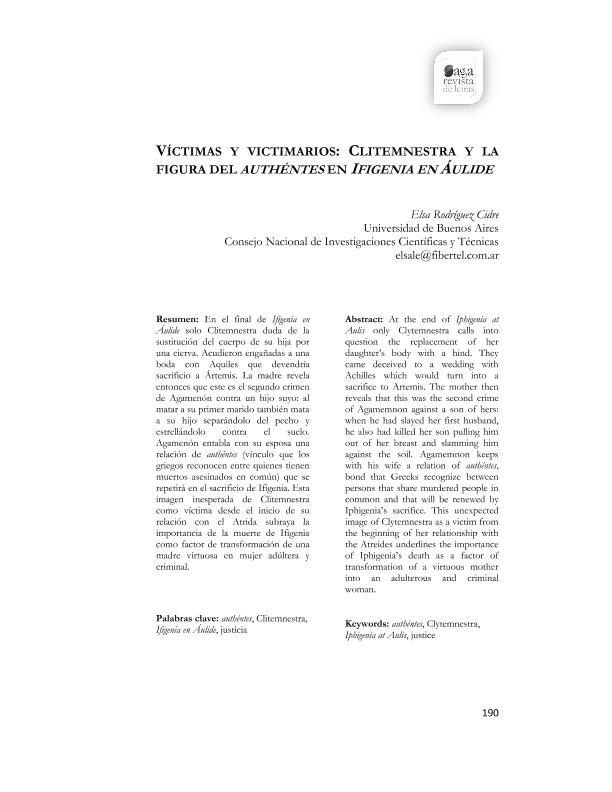Artículo
En el final de Ifigenia en Áulide solo Clitemnestra duda de la sustitución del cuerpo de su hija por una cierva. Acudieron engañadas a una boda con Aquiles que devendría sacrificio a Ártemis. La madre revela entonces que este es el segundo crimen de Agamenón contra un hijo suyo: al matar a su primer marido también mata a su hijo separándolo del pecho y estrellándolo contra el suelo. Agamenón entabla con su esposa una relación de authéntes (vínculo que los griegos reconocen entre quienes tienen muertos asesinados en común) que se repetirá en el sacrificio de Ifigenia. Esta imagen inesperada de Clitemnestra como víctima desde el inicio de su relación con el Atrida subraya la importancia de la muerte de Ifigenia como factor de transformación de una madre virtuosa en mujer adúltera y criminal. At the end of Iphigenia at Aulis only Clytemnestra calls into question the replacement of her daughter’s body with a hind. They came deceived to a wedding with Achilles which would turn into a sacrifice to Artemis. The mother then reveals that this was the second crime of Agamemnon against a son of hers: when he had slayed her first husband, he also had killed her son pulling him out of her breast and slamming him against the soil. Agamemnon keeps with his wife a relation of authéntes, bond that Greeks recognize between persons that share murdered people in common and that will be renewed by Iphigenia’s sacrifice. This unexpected image of Clytemnestra as a victim from the beginning of her relationship with the Atreides underlines the importance of Iphigenia’s death as a factor of transformation of a virtuous mother into an adulterous and criminal woman.
Víctimas y victimarios: Clitemnestra y la figura del authéntes en Ifigenia en Áulide
Fecha de publicación:
03/2016
Editorial:
Universidad Nacional de Rosario. Facultad de Humanidades y Artes. Escuela de Letras
Revista:
Saga.
ISSN:
2408-4409
Idioma:
Español
Tipo de recurso:
Artículo publicado
Clasificación temática:
Resumen
Palabras clave:
AUTHÉNTES
,
CLITEMNESTRA
,
IFIGENIA EN ÁULIDE
,
JUSTICIA
Archivos asociados
Licencia
Identificadores
Colecciones
Articulos(SEDE CENTRAL)
Articulos de SEDE CENTRAL
Articulos de SEDE CENTRAL
Citación
Rodríguez, Elsa; Víctimas y victimarios: Clitemnestra y la figura del authéntes en Ifigenia en Áulide; Universidad Nacional de Rosario. Facultad de Humanidades y Artes. Escuela de Letras; Saga.; 5; 3-2016; 190-210
Compartir




